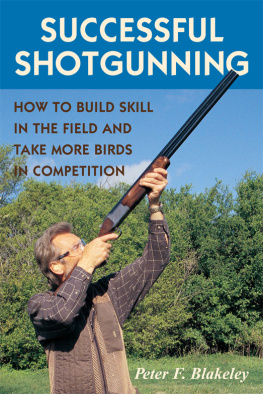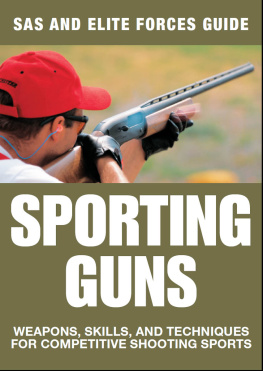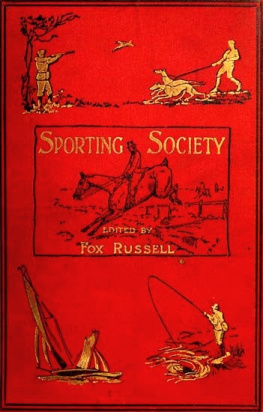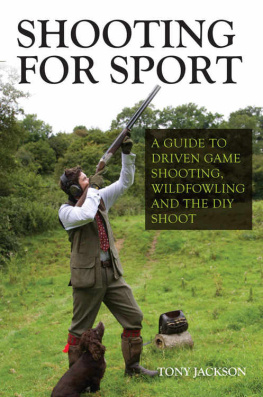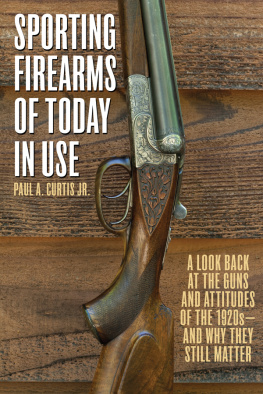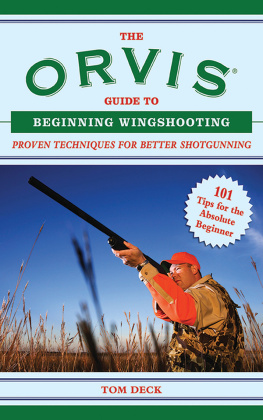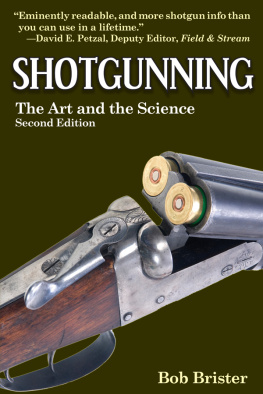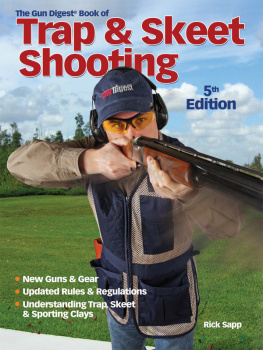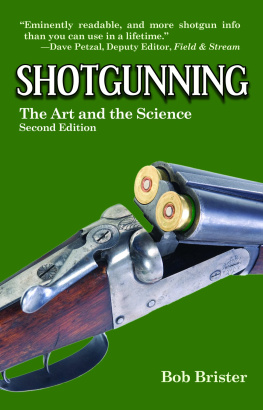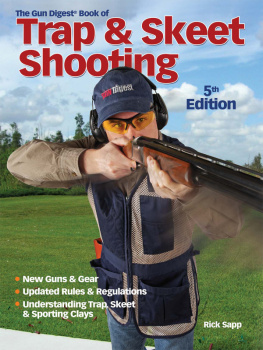Copyright 2003 by Stackpole Books
Published by
STACKPOLE BOOKS
5067 Ritter Road
Mechanicsburg, PA 17055
www.stackpolebooks.com
All rights reserved, including the right to reproduce this book or portions thereof in any form or by any means, electronic or mechanical, including photocopying, recording, or by any information storage and retrieval system, without permission in writing from the publisher. All inquiries should be addressed to Stackpole Books, 5067 Ritter Road, Mechanicsburg, Pennsylvania 17055.
Printed in the United States
First edition
10 9 8 7 6 5
Cover photo by Hollie Blakeley
Cover design by Caroline Stover
Illustrations by Linda Rogers
Library of Congress Cataloging-in-Publication Data
Blakeley, Peter F.
Successful shotgunning : how to build skill in the field and take more birds in competition / by Peter F. Blakeley. 1st ed.
p. cm.
Includes index.
ISBN 0811700429 (hardcover)
eISBN 9780811743709
1. Trapshooting. I. Title.
GV1181 .B52 2003
799.3132dc21
2003003848
ISBN 978-0-8117-0042-9
To Alison,
my eternally patient
and supportive wife
CONTENTS
FOREWORD
Peter Blakeley is one of the most involved, enthusiastic, and animated shotgunning aficionados I have known in my thirty years plus of competing. Since I do most of my practicing at the Dallas Gun Club, I have experienced a few years of the Peter Blakeley experience. Peter gives about 150 percent all the time. If he is not teaching on the field, he is discussing shooting theory with other shotgunners, or is changing the sporting clays course, or is writing an article for a shooting magazine, or is looking for someone with whom to discuss the finer points of shotgunning. I have rarely seen him stand still. And as I see it, all his efforts are in an attempt to achieve his ultimate goal: the tireless pursuit of the art of shotgunning.
At first, communications with Peter were not crystal clear. When a heavily accented Scot tries to carry on a conversation with a native Texan, one would have a very difficult time believing that both are speaking the same language. I have adjusted, however, and now know that shotgoon means shotgun.
As we come from different backgrounds, we were often wary of each others philosophy regarding certain shotgunning theories. But after many discussions, I can honestly say that I have benefited greatly from Peters philosophy and his unique presentation. He has given this old skeet shooter a fresh perspective on shooting theory.
Peter has compiled a treasure of great information and shooting theory, along with some great shotgunning tales. Pay attention to what he has to say.
Robert Paxton is a thirty-two-time all-American skeet shooter, two-time high overall world champion, and nine-time Texas state champion, and he has set numerous world records throughout his shooting career. Robert was inducted into the National Skeet Shooting Association Hall of Fame in 1995.
PREFACE
This book is based on my personal knowledge of shooting methods, including over forty years of wingshooting, over thirty years of sporting clays experience, and over twenty-four years as a full-time shooting instructor in the United Kingdom and here in the States. During those years, I have written many instructional letters and articles. I currently write articles for Sporting Clays magazine. I have a genuine enthusiasm and willingness to communicate all this accrued knowledge to you, the shooter. However, the contents of this book should never be considered a substitute for shooting lessons. Quality shooting instruction is a worthwhile commodity, and long-term involvement with a good coach should improve anyones game tremendously. Nor is this book for beginners, although it contains material that is beneficial to the beginner. I hope you will come to think of Shotgunning as a reference book, one that offers a better understanding of the shooting process as a wholea guide to the evaluation of targets in wingshooting situations either in the field or a competitive environment, such as on a sporting clays course or skeet field.
Some guys will tell you that their success with a shotgun is unimportant to them. You know, the I dont care if I hit anything, I just like to see the dogs working, feel the wind in my hair, and be at one with nature guys. Really? I dont believe any of it. Nobody likes to miss, and with good instruction, everyone can improve. Nobody hits them all, either, and a bad days shooting is often more enjoyable than a good day of doing some of the more menial tasks that take up large chunks of our lives, but make no mistake, the enjoyment of the shooting experience as a whole is defined ultimately by the proficiency with which we use a shotgun. So heres something to think about. The aspiring shotgunner has absolutely no control over any airborne target. Once he triggers the shot, its over. It would make sense, therefore, to pay more attention to the things that he can controlgun fit, stance, mount, swing, and most important of all, visual ability to accurately evaluate all the variables involved. This book will show you how.
ACKNOWLEDGMENTS
During the course of my shooting life, many people have influenced my decision to write this book. Many of them are valued personal friends and acquaintances who contributed in some way with their vast accumulations of knowledge of the sport of shotgunning. (This isnt to say that, on various shooting-related topics, we are always in agreement.) They include Andy McCloud, head keeper on Lord Edgertons estate in Cheshire; Bob Brister, Shot-Gunning: the Art and the Science; Cyril S. Adams, Lock, Stock & Barrel; Michael Yardley, Gun Fitting: the Quest for Perfection; Sam Shiller, ZZ bird (Helice) champion; Roger Silcox, Clay Pigeon Shooting Associaton (CPSA) staff tutor; Mick Howells, former 1996 Sporting Clay World Champion; Robert Paxton, thirty-two-time all-American skeet champion; Brian Mitchell, head grouse keeper on the Duke of Buccleuchs estate in Langholm; John Baxter, head keeper at Westerhall Estate; Patrick Hope-Johnstone, his Grace the Earl of Annandale; David Hope-Johnstone, the young Earl; and Thomas Florey, estate manager, Earl of Annandales estate, Southwest Scotland. I thank Barbara Dickson, Mace McCain, Martin F. Bubba Wood, and Bob Troutt for their advice and help with photographs. Last but not least, I give special thanks to my friend Ralph Cush Cushman from Anchorage, Alaska, who dedicated many hours of his spare time to edit the manuscript. Cush is a rare find; editors with his combination of literary skills and expert knowledge of the art of shotgunning are few and far between. He did an admirable job.
INTRODUCTION
It has been my pleasure and privilege, over the last thirty-five years or so, to meet many shooting men who are skilled and accomplished with a shotgun. During most of those years, I lived in an ideal location, with some of the best sporting estates in the world within view of my doorstep. Ive seen shots that can pull a stratospheric, soaring archangel cock pheasant from the clouds high above a wooded glen at Westerhall Estate, and others that can successfully decipher all the directional changes and intercept a heather-hugging red grouse as it rides the wind over the misty, purple hills of the Roan Fell. Ive seen the guys who can stroke a white-wing dove, cruising the thermals of a hot Texas breeze out of the sky, and the quail hunters who can snap-shoot a bobwhite with the speed of a striking rattlerquicker than most of us can blink an eye. Ive seen Robert Paxton, thirty-two-time all-American skeet champion and one of the best skeet shooters in the world, systematically pulverize targets with enviable precision. Ive watched former World Sporting Clays Champion Mick Howells pause for a moment before taking a second, successful shot at a target that defeated him on the first. The parameters are the same; all these guys have something in commonthey dont succeed by accident. They are all specialists in their own particular way. They have honed their skills and refined their techniques to the point where there is no guesswork involved. They have developed the ability to evaluate moving targets and put their shot pattern precisely where it is needed. Anyone who believes that these men have the ability to do this because of some inherent trait, and that they have become expert shots by relying on instinct alone, should think again; it just doesnt happen. The so-called natural shot is as mythical as the unicorn.

